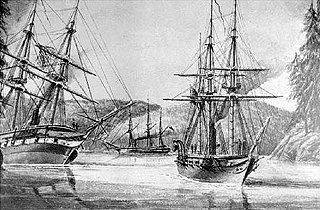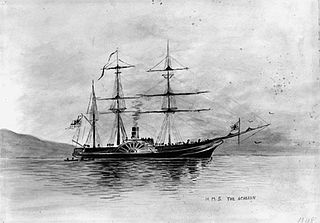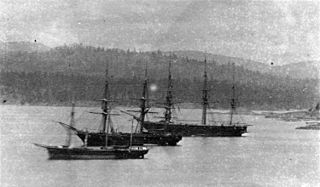
HMS Plumper was part of the 1847 programme, she was ordered on the 25 of April as a steam schooner from Woolwich Dockyard with the name Pincher. However, the reference Ships of the Royal Navy, by J.J. College, (c) 2020 there is no entry that associates this name to this build. The vessel was reordered on August 12 as an 8-gun sloop as designed by John Fincham, Master Shipwright at Portsmouth. Launched in 1848, she served three commissions, firstly on the West Indies and North American Station, then on the West Africa Station and finally in the Pacific Station. It was during her last commission as a survey ship that she left her most enduring legacy; in charting the west coast of British Columbia she left her name and those of her ship's company scattered across the charts of the region. She paid off for the last time in 1861 and was finally sold for breaking up in 1865.

HMS Acheron was the last Hermes-class wooden paddle sloop ordered for the Royal Navy. She was launched at Sheerness in 1838. She spent two commissions in the Mediterranean before being reclassed as a survey ship in 1847. Between 1848 and 1851 she made a coastal survey of New Zealand, the first such survey since Captain Cook. She was paid off at Sydney and was tender to HMS Calliope. She was sold at Sydney in 1855.

HMS Salamander was one of the initial steam powered vessels built for the Royal Navy. On 10 January 1831 the First Sea Lord gave orders that four paddle vessels be built to competitive designs. The vessels were to be powered by Maudslay, Son & Field steam engines, carry a schooner rig and mount one or two 10-inch shell guns. Initially classed simply as a steam vessel (SV), she was re-classed as a second-class steam sloop when that categorization was introduced on 31 May 1844. Designed by Joseph Seaton, the Master Shipwright of Sheerness, she was initially slated to be built in Portsmouth, and was changed to Sheerness Dockyard. She was launched and completed in 1832, took part in the Second Anglo-Burmese War and was broken up in 1883.

HMS Malacca was a 17-gun wooden sloop of the Royal Navy. She was ordered on 9 November 1847 from Moulmein, Burma to be built of teak. As a Surveyor's Department design, Malacca was based on the Conflict designed sloop which was approved on 9 December 1848. After launching in April 1853 she was commissioned the following month to be sailed to England for the fitting of her engine. She entered British Naval service in 1854 and served three commissions including action in the Russian War 1854 - 55 before being sold in 1869. Her resale to Japan, she served in the Japanese Navy as a training ship until broken in 1906.

On 26 March 1846, two vessels were ordered from Deptford Dockyard as Rifleman-designed gunvessels named Archer and Parthian. However, on 9 September 1846 the orders for both vessels were suspended prior to the vessels being laid down. On 25 April 1847 two vessels were ordered to the improved Rattler-type screw sloops as designed by John Edye of the Surveyor's Department from Deptford Dockyard. The first vessel, Archer may have been the change of the build from the Rifleman type to the sloop design. The second vessel, Wasp, appears to be a new vessel as the build for the Parthian remained on the books at Deptford until June 1849, when it was cancelled. Archer received the machinery from the gunvessel Rifleman, which resulted in an increase of speed over Wasp. Wasp's hull was sheathed in Muntz metal to retard marine growth. Their armament would increase from 12 to 15 guns over their careers. Both vessels would participate in the Russian War of 1854–1855. Both would be broken by 1869.

HMS Dee was the first paddle steamer ordered for the Royal Navy, designed to carry a significant armament. She was ordered on 4 April 1827 from Woolwich Dockyard. She was designed by Sir Robert Seppings, Surveyor of the Navy and modified by Oliver Lang. This vessel was considered as new construction as a previous vessel ordered as a flush deck Cherokee-class brig in 1824, had been renamed African in May 1825. She was initially classed as a steam vessel (SV), and in 1837 reclassified as a steam vessel class 2 (SV2). She was converted to a troopship in May 1842 and as a second class sloop in 1846. She was converted into a storeship in 1868. She was broken at Sheerness in 1871.

HMS Hermes was a Hermes-class wooden paddle sloop of the Royal Navy. She was built at Portsmouth Dockyard. Initially she was used as apackey vessel until her guns were upgraded. She was re-engined and lengthened in 1842 to 43. She spent time on various stations in the Empire. She participated in the storming of Rangoon during the Second Burmese War. She was sold for breaking in October 1864.
HMS Archer was initially ordered as one of two Rifleman type gunvessels on 25 April 1846. With her construction suspended in September 1846, she was reordered on as a sloop on 25 April 1847 to be constructed to a design of John Edye as approved on 25 August. With the exception of two years on Baltic service during the Russian War of 1854 to 1855 she spent the majority on the West Coast of Africa on the anti-slavery patrol. This service involved anti-slavery work on the coasts of the Bight of Benin, and was notoriously unhealthy, with tropical diseases taking a heavy toll of British seamen. One of her commanders died and three others were invalided. Archer was reclassified as a corvette in 1862. She finally returned to Home waters, being sold for breaking in January 1866
HMS Medea was one of the initial steam-powered vessels built for the Royal Navy. On 10 January 1831 the new First Lord Sir James Graham, 2nd Baronet gave orders that four paddle vessels be built to competitive designs. The vessels were to be powered by Maudslay, Son & Field steam engines, carry a schooner rig and mount one or two 10-inch shell guns. Initially classed simply as a steam vessel (SV), she was re-classed as a second-class steam sloop when that categorization was introduced on 31 May 1844. Designed by Oliver Lang, the master shipwright of Woolwich. She was launched and completed in 1834, took part in the Syrian Coast Campaign and was broken up in 1867.
HMS Volcano was a Hermes-class wooden paddle sloop of the Royal Navy. She was built at Portsmouth Dockyard. She was launched in 1836. Her first few commissions were on packet service in the Mediterranean and North American and West Indies Stations and on the anti-slavery patrol on the West Coast of Africa. In 1854 she was converted to a factory ship and served in the Baltic during the Russian War. She was sent to China during the Second Opium War as a factory ship. On her return she was assigned to Portsmouth, on Harbour Service as a stationary factory ship. She remained there until sold for breaking in 1894.
HMS Stromboli was initially a Steam Vessel second class designed by Sir William Symonds, Surveyor of the Navy, and built at Portsmouth. She was commissioned and participated in the bombardment of Acre in 1840, during the Russian War she was used as a troop transport in the Baltic in 1854, she was in the Black Sea and the Sea of Azov in 1855. Her last overseas posting was on the South East Coast of America. She was sold for breaking in August 1866.
HMS Vesuvius was initially a Steam Vessel second class designed by Sir William Symonds, Surveyor of the Navy, and built at Sheerness. She was commissioned and participated in the bombardment of Acre in 1840, during the Russian War she was in the Black Sea and the Sea of Azov in 1855. Her last overseas posting was in the West Indies. She was sold for breaking in June 1865.
HMS Alecto was an Alecto-class sloop designed by Sir William Symonds, Surveyor of the Navy. Originally classed as a steam vessel (SV3), her classification would be changed to a Third Class Sloop. She initially served in the Mediterranean, prior to her tug of war with the Rattler. She spent her time in the Americas and mainly on the anti-slavery patrol off the west coast of Africa. She was broken in November 1865
HMS Prometheus was an Alecto-class sloop designed by Sir William Symonds, Surveyor of the Navy. Originally classed as a steam vessel (SV3), her classification would be changed to a Third Class Sloop. She initially served mainly on the west coast of Africa on the anti-slavery patrol except for a brief period on particular service in the Black Sea in late 1855. She was sold on 5 March 1863 for breaking.
HMS Polyphemus was an Alecto-class sloop designed by Sir William Symonds, Surveyor of the Navy. Originally classed as a steam vessel (SV3), her classification would be changed to a Third Class Sloop. She initially served in the Mediterranean, west coast of Africa and the Baltic. She was wrecked on the Baltic side Jutland on 29 January 1856.
HMS Inflexible was a Bulldog-class sloop designed by Sir William Symonds, Surveyor of the Navy. Originally she was ordered as a Driver-class sloop, however, under Admiralty Order of 26 December 1843 she was directed to be built to a new specification. After commissioning she sailed for the East Indies and participated in the last year of the New Zealand War of 1845 to 1847. She then was in the Black Sea for the Russian War followed by the Second Opium War with China. She was sold for breaking in July 1864.
HMS Scourge was a Bulldog-class sloop designed by Sir William Symonds, Surveyor of the Navy. Originally she was ordered as a Driver-class sloop, however, under Admiralty Order of 26 December 1843 she was directed to be built to a new specification. She was initially commissioned for service with the Channel Squadron before moving to the North America and West Indies Station. She then served in the Mediterranean then the west coast of Africa. Her final service was in the Mediterranean. She was broken in 1865.
HMS Fury was a Bulldog-class sloop designed by Sir William Symonds, Surveyor of the Navy. She was ordered on 19 February 1844. After commissioning she sailed for the East Indies and participated in action against pirate junks near Vietnam. She then was in the Black Sea for the Crimean War followed by the Second Opium War with China. She was sold for breaking in July 1864.
HMS Port Mahon was a member of the Gibraltar Group of 24-gun sixth rates. After commissioning she spent her career in home waters and North America on trade protection duties. She was broken up at Plymouth in May 1740.
HMS Portsmouth was a fifth rate built under the 1689 programme built at Deptford Dockyard. Her guns were listed under old terms for guns as demi-culverines, sakers and minions. After commissioning she spent her short career with the Fleet in Home Waters. She was taken by the French in 1696.








